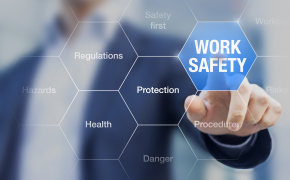Coronavirus: OSHA Considerations for Employers
As the number of novel coronavirus disease (“COVID-19”) cases continue to grow in the United States, employers should be aware of their legal obligations under the Occupational Safety and Health Act of 1970 (“OSH Act”) and key guidance relating to worker exposure to the coronavirus (known formally as “Novel Coronavirus SARS-CoV-2”). Employers have an obligation to protect their employees from exposure to the coronavirus under the OSH Act’s General Duty Clause and certain OSHA standards. In addition, both the Occupational Safety and Health Administration (“OSHA”) and the Centers for Disease Control and Prevention (“CDC”) have issued guidance on steps that employers can take to prevent workplace exposures to the coronavirus. We recommend that you review the plans and strategies you have in place to protect your workers from exposure to the coronavirus, verify that they incorporate these legal requirements and recommended practices, maintain good communication with your employees, and continue to monitor for new developments, adjusting as necessary to address evolving circumstances.
OSHA Obligations
Section 5(a) of the OSH Act requires each employer to: (1) “furnish to each of his employees employment and a place of employment which are free from recognized hazards that are causing or are likely to cause death or serious physical harm to his employees,” and (2) “comply with occupational safety and health standards promulgated under” the OSH Act. 29 USC § 654(a). In addition, employers must comply with the recordkeeping and reporting requirements for occupational injuries and illnesses that are set forth in 29 C.F.R. Part 1904.
- General Duty Clause: The requirement to furnish employees with “employment and a place of employment which are free from recognized hazards that are causing or are likely to cause death or serious physical harm” is known as the OSH Act General Duty Clause. With respect to the potential for employee exposure to the coronavirus, the General Duty Clause arguably requires employers to implement feasible and useful methods to address potential exposures. If an employer fails to take measures to address the potential for employee exposure to the coronavirus, the employer could be subject to liability under the General Duty Clause.
- Occupational Safety and Health Standards: While there are no specific OSHA standards that are specific to the coronavirus, the following standards may be applicable in addressing employee exposure to the coronavirus:
- Personal Protective Equipment (PPE), 29 C.F.R. 1910 Subpart I: Employers have an obligation under 29 C.F.R. § 1910.132 to assess the hazards in their workplace, select appropriate PPE, and provide the selected PPE to their employees for use. Depending upon an employee’s work task, setting, and potential exposures (to the coronavirus and/or chemicals used for cleaning and disinfection), employers should assess whether PPE such as gloves, eye and face protection, and respiratory protection may be necessary. If respirators are necessary to protect workers, employers are required to have a comprehensive respiratory protection program in accordance with 29 C.F.R. § 1910.134. If respirators are not deemed necessary but voluntary use is permitted by the employer, the employer should also be aware of its obligations under 29 C.F.R. § 1910.134(c)(2).
- Sanitation Standard, 29 C.F.R. § 1910.141: Employers have an obligation under the Sanitation Standard to keep their workplaces clean “to the extent that the nature of work allows,” and to take specific measures to ensure sanitary conditions. Employers should ensure that they are implementing these measures as they may help prevent employee exposures to the coronavirus.
- Hazard Communication Standard, 29 C.F.R. § 1910.1200: Employers have an obligation under the Hazard Communication Standard to provide information to their employees about hazardous chemicals to which they are exposed. If workers will be exposed to hazardous chemicals for the purposes of cleaning and disinfection, employers should ensure that their hazard communication program addresses the hazards.
- Access to Employee Exposure and Medical Records, 29 C.F.R. § 1910.1020: Employers have an obligation to maintain and provide employees with a right of access to their exposure and medical records. To the extent that employers have employee exposure or medical records related to coronavirus exposure, they must maintain and provide a right of access to those records in accordance with 29 C.F.R. § 1910.1020.
- Recordkeeping and Reporting Requirements: Employers are required under 29 C.F.R. § 1904.4 to keep records of certain work-related injuries, illnesses, and fatalities. While cases of the common cold and flu are exempt from recording under 29 C.F.R. § 1904.5(b)(2)(viii), OSHA has clarified that COVID-19 does not fall under that exemption. As a result, if an employer is infected from coronavirus exposure in the workplace and one or more of the general recording criteria in 29 C.F.R. § 1904.7 is present, an employer is obligated to record that illness. For example, self-quarantining by an employee infected due to workplace exposure to the coronavirus would likely result in days away from work. In addition, if such infection were to result in an in-patient hospitalization or fatality, an employer may have to report that information to OSHA promptly pursuant to 29 C.F.R. § 1904.39.
Twenty-eight states have OSHA-approved State Plans in place. These State Plans must have standards and enforcement programs that are at least as effective as those of OSHA, and may contain additional state-specific requirements. Employers in State Plan states should be aware of any state-specific requirements that might apply to coronavirus exposure. For instance, the California Division of Occupational Safety and Health (“Cal/OSHA”) has promulgated an Aerosol Transmissible Diseases Standard, 8 C.C.R. § 5199, that applies to certain health care facilities. It contains requirements to protect employees from diseases and pathogens transmitted by aerosols. Helpful information also appears in Cal/OSHA’s California Workplace Guide to Aerosol Transmissible Diseases (Jan. 2020).
Cal/OSHA also requires employers in that state to maintain an Injury and Illness Prevention Program (IIPP), 8 C.C.R. § 3203. It requires employers to update their IIPPs whenever they become aware of a new or previously unrecognized hazard, which conceivably could include potential for exposure to the coronavirus. OSHA does not have its own IIPP requirement, but it does have its own Injury and Illness Prevention Programs White Paper (Jan. 2012), which may prove useful as well.
Guidance for Employers
Both OSHA and the CDC have issued guidance on the steps that employers can take to prevent workplace exposures to the coronavirus.
- OSHA Guidance: OSHA has issued a guidance document that it developed in collaboration with the CDC and created a webpage with information about the coronavirus and COVID-19, hazard recognition, applicable standards, steps that can be taken to prevent worker exposure, and additional resources. OSHA recommends that every employer:
- develop an infectious disease preparedness and response plan that addresses the levels of risk associated with various worksites and job tasks, including where, how, and to what sources of coronavirus workers might be exposed, and non-occupational risk factors at home and in community settings; the individual risk factors for workers (e.g., older age, chronic medical conditions, pregnancy); and controls necessary to address those risks;
- prepare to implement basic infection prevention measure such as promoting frequent and thorough hand washing, encouraging workers to stay home if they are sick, encouraging respiratory etiquette, and maintain regular housekeeping practices;
- develop policies and procedures for prompt identification and isolation of sick people, if appropriate, including policies and procedures for employees to report when they are sick or experiencing symptoms of COVID-19;
- develop and implement workplace flexibilities and protections that actively encourage sick employees to stay at home, recognize that workers with ill family members may need to stay home to care for them, are consistent with public health guidance, and provide workers with information regarding workplace health and safety; and communicate with workers about these flexibilities and protections so that they remain informed;
- implement engineering controls (e.g., high-efficiency air filters, ventilation controls, physical barriers), administrative controls (e.g., encouraging sick workers to stay at home, minimizing contact among workers and others, developing emergency communications plans, providing training), safe work practices (providing resources and an environment that promote personal hygiene, requiring regular hand washing or use of alcohol-based hand rubs, posting handwashing signs), and PPE (e.g., gloves, goggles, face shields, face masks, respiratory protection) that are tailored to employee’s risk of exposure; and;
- follow existing OSHA standards that may apply to protecting workers from exposure to the coronavirus, such as OSHA’s PPE standard.
OSHA also recommends that employers consult the CDC guidance described below. In discussing applicable standards and potential control measures, OSHA’s guidance notes that even though OSHA’s Bloodborne Pathogens Standard, 29 C.F.R. § 1910.1030, would not usually apply to the respiratory secretions that may transmit the coronavirus, it offers a useful framework that may help control some sources of the virus.
- CDC Guidance: The CDC has developed Interim Guidance for Businesses and Employers to Respond to Coronavirus Disease 2019 (COVID-19). This guidance recommends several strategies for employers to use to help prevent workplace exposures to the coronavirus. These strategies include:
- actively encouraging sick employees to stay home;
- separating sick employees;
- emphasizing that employees should stay home when sick;
- directing employees to practice respiratory etiquette and good hand hygiene;
- performing frequent environmental cleaning;
- advising employees of certain precautions before traveling; and
- taking measures when there are confirmed coronavirus exposures (either of an employee or a family member).
The CDC encourages employers to be flexible and involve employees in developing and reviewing their plans.
Employers should be aware that EPA has authorized anti-coronavirus claims for certain disinfectants. For further information, see our alert on that topic.
Employers are encouraged to keep track of current travel warning notices, such as by checking the CDC’s Travel Information webpage, and provide guidance to their employees accordingly. At this time, CDC recommends avoiding all nonessential travel to China, Iran, South Korea, and Italy. It recommends that older adults and those with chronic medical conditions postpone travel to Japan, and that usual precautions be taken for travel to Hong Kong.
For some employees, teleconferencing can reduce the need for travel or even physical presence in the workplace. Employers should keep in mind, however, that adequate staffing on-site is an important aspect of the Process Safety Management Standard, under 29 C.F.R. § 1910.119(e)(3)(vi) (human factors).
Conclusions
While workers in some industries are at greater risk of coronavirus exposure than others, there is some risk to workers across all industries due to the community spread that is increasing in the United States. Employers should ensure that they have strategies in place that meet their OSHA obligations and to protect workers from coronavirus exposure. For assistance, please contact Jayni Lanham at 410-230-1333, [email protected], or Mark Duvall at 202-789-6090, [email protected].
Beveridge & Diamond’s Occupational Safety and Health practice group works alongside clients’ legal, EHS and technical teams, to help resolve critical enforcement, compliance, and regulatory issues relating to their facilities and operations. For more information, please contact the authors.














